How I Developed This Recipe
Ever craved the satisfying sizzle of Pepper Rice (ペッパーライス) but dreaded the thought of battling traffic to get it? Imagine thinly sliced beef crisping beautifully on a hot plate, grains of rice soaking in savory juices, and the sweet crunch of corn, all coming together effortlessly in your own kitchen.
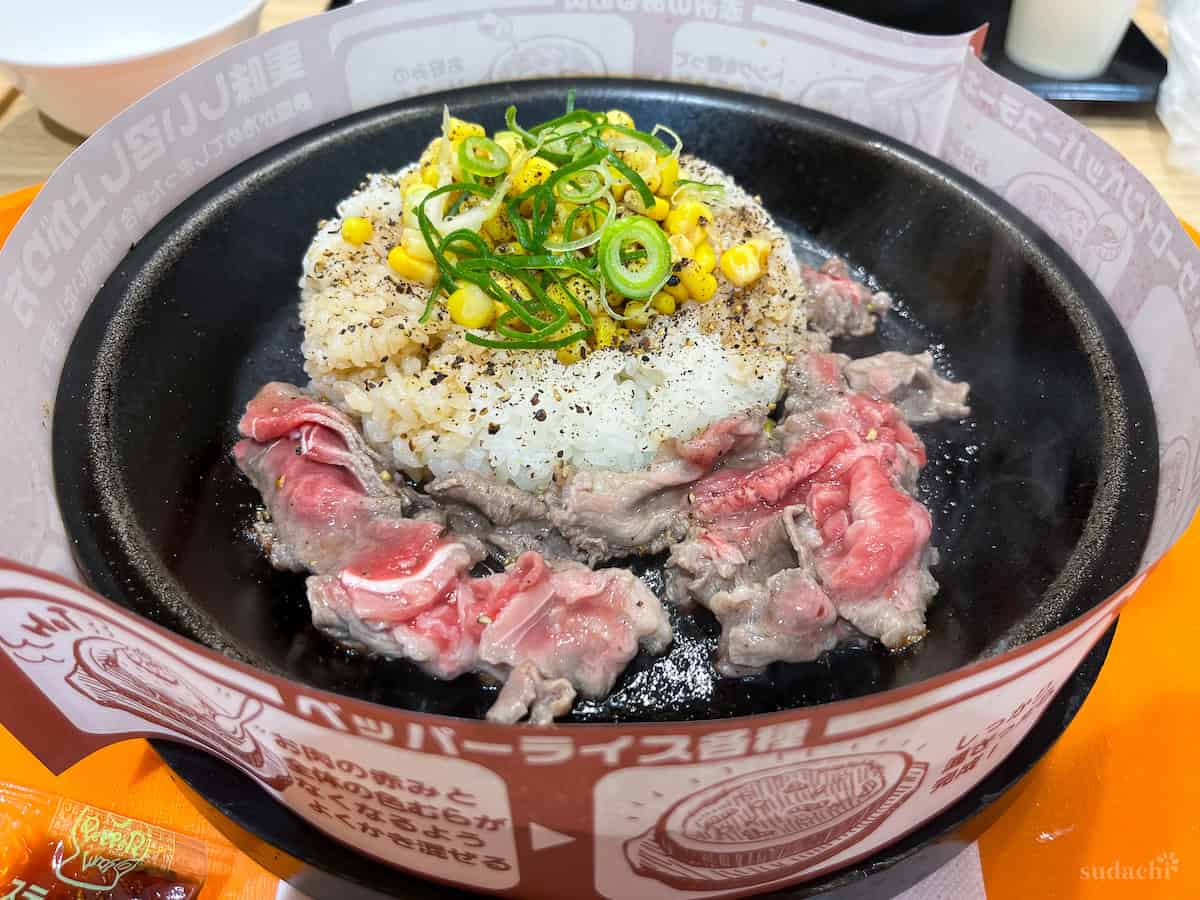
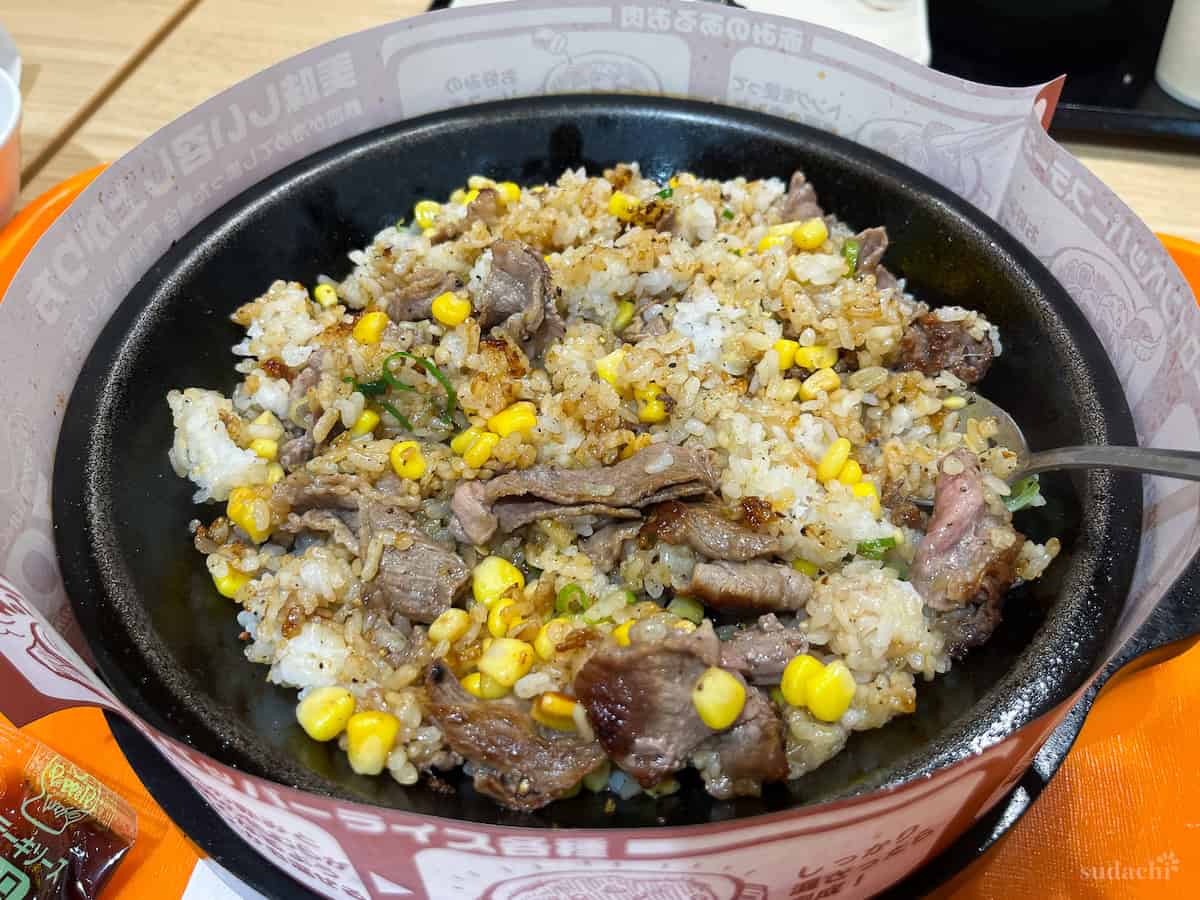
You’re probably thinking this sounds too complicated for a weeknight. But what if I told you you can recreate that Japanese restaurant sizzle in just 20 minutes using a regular frying pan on a Tuesday night?

Pepper Rice is remarkably easy to recreate because it has such a straightforward concept. It’s simpler than many copycat dishes I’ve cooked before. This time, I stuck closely to the original concept but added my own flavorful twist. Ready to transform your hectic dinner routine into something genuinely exciting?
Key Ingredients & Substitution Ideas

- Thinly sliced beef: The best cuts are beef short plate (used in pepper rice) and other thinly sliced, well-marbled beef cuts found at Asian markets labeled “shabu-shabu” or “hot-pot”. But this is a very forgiving recipe, so thinly sliced pork belly even works wonderfully.
- Rice: Japanese short-grain rice or medium-grain varieties like Calrose (often branded as “sushi rice”) create that perfect sticky texture that holds together when molded in the pan.
- Essential seasonings: Never compromise on soy sauce and mirin. However, feel free to substitute sake with dry white wine, or swap Asian chicken bouillon powder for any quality bouillon or stock powder you have on hand.
Visual Walkthrough & Tips
Here are my step-by-step instructions for how to make Beef Pepper Rice at home. For ingredient quantities and simplified instructions, scroll down for the Printable Recipe Card below.
If you prefer to watch the process in action, check out my YouTube video of this Pepper Rice recipe for a complete visual walkthrough!
Whisk together the sauce ingredients (soy sauce, mirin, sake, ketchup, sesame oil, honey, grated garlic, chicken bouillon powder, grated onion, grated apple, grated ginger, and chili powder) until smooth.

Use half of this sauce to marinate your thinly sliced beef for 10 minutes, ensuring each piece is well-coated.
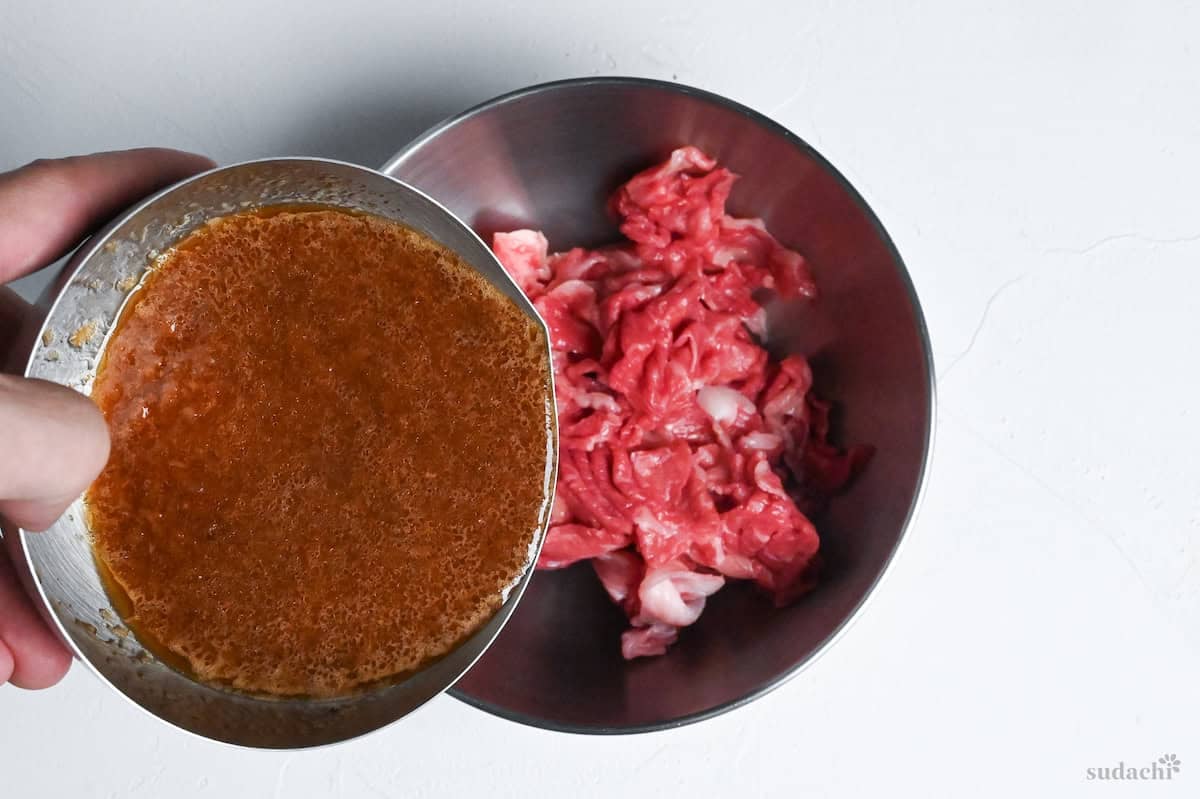
Make sure to only use HALF of the sauce and save the rest for later.

The real pepper rice doesn’t marinate the meat, but the marinade penetrates the thin slices quickly, infusing them with layers of flavor that develop beautifully during cooking.
The grated apple and onion not only add sweetness but also contain natural enzymes that help tenderize the meat.

Place your cooked rice (feel free to use leftover rice) directly in the center of a large frying pan and generously grind fresh black pepper over the rice. This is your chance to make it truly “pepper” rice, so don’t hold back!
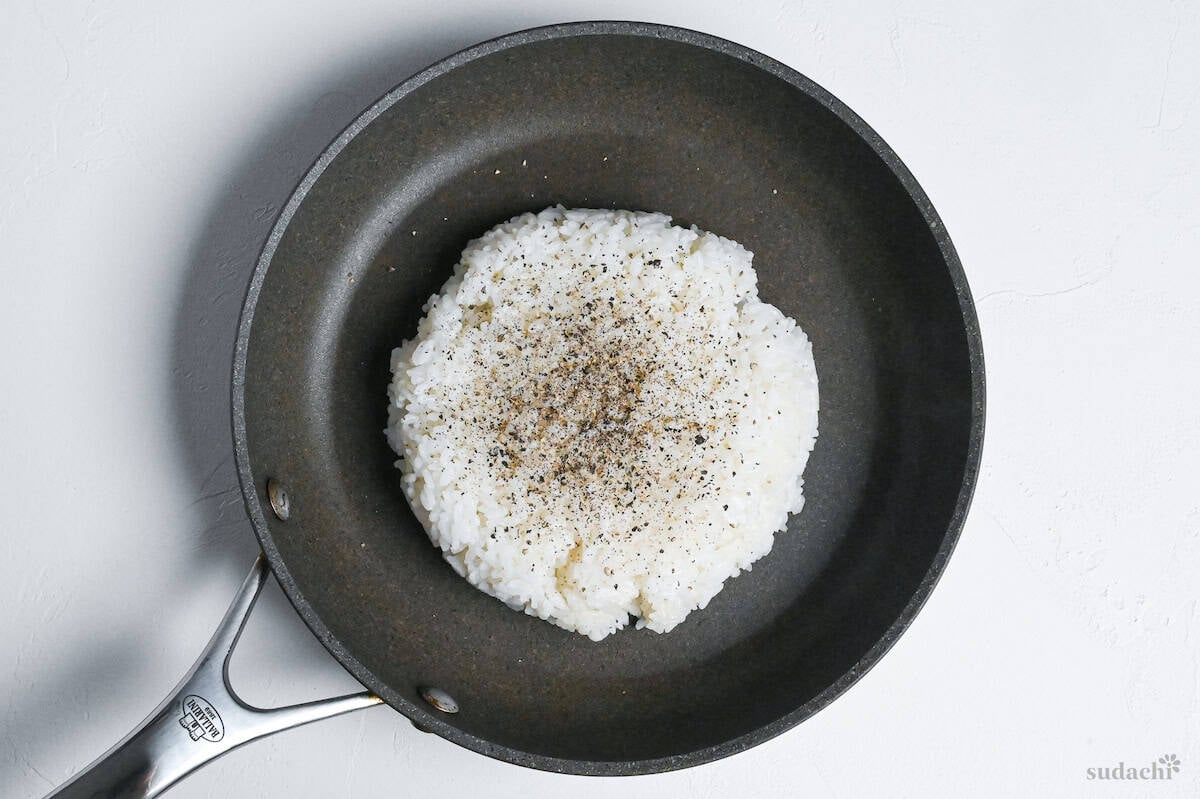
Top with well-drained corn kernels, chopped green onions, and a pat of butter right on the rice. Arrange the marinated beef around the rice, creating a ring that will cook evenly.
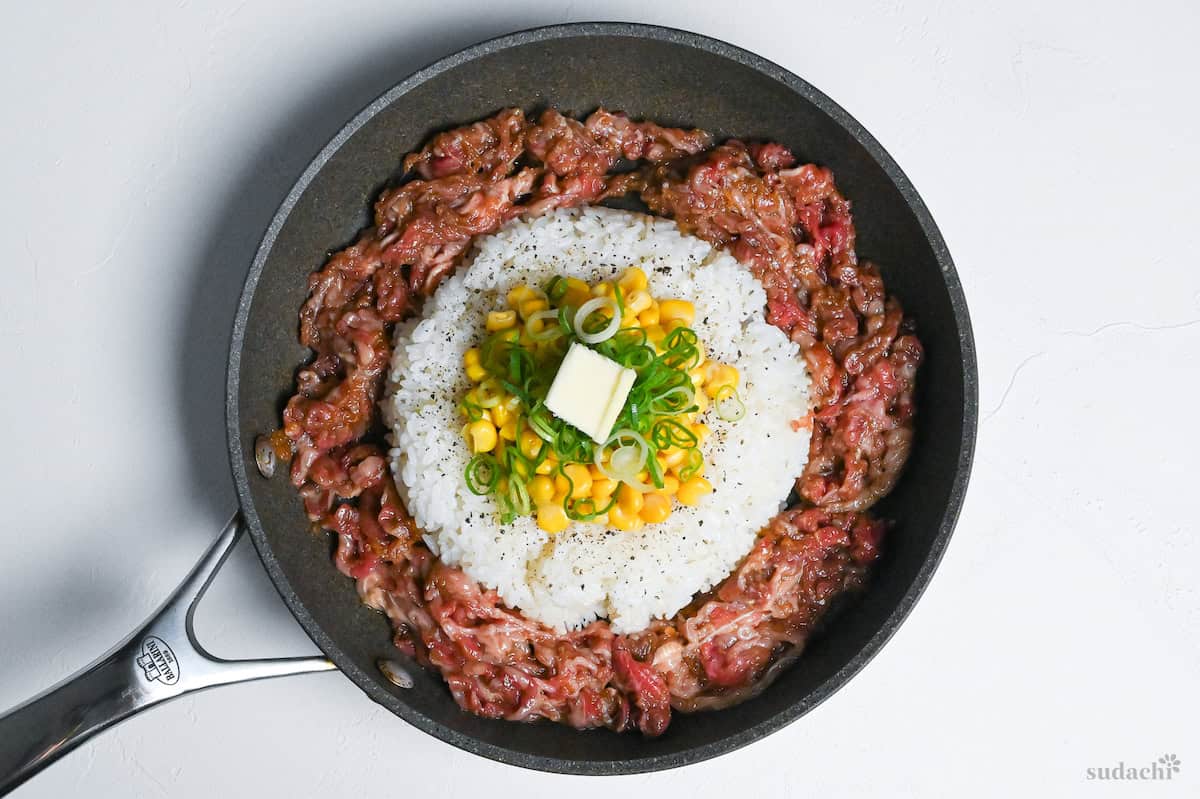
Cover the pan and cook over medium heat for 5 minutes.
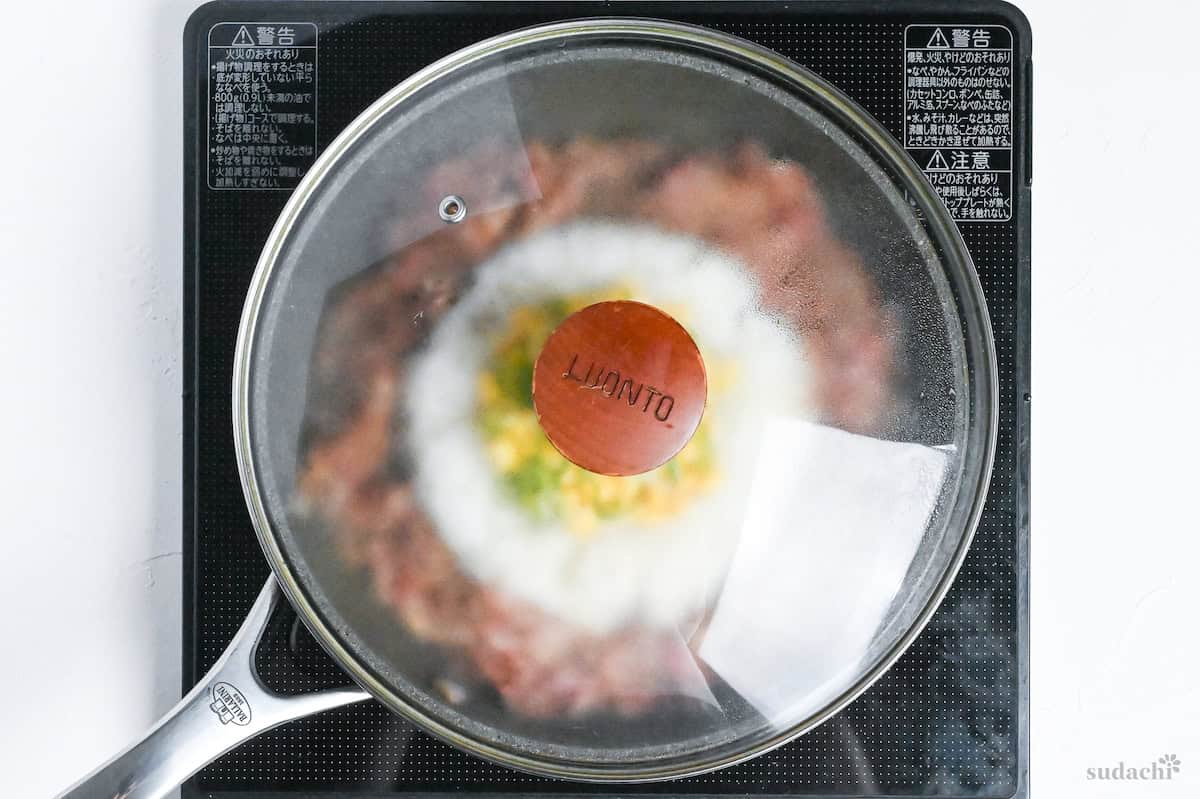
Remove the lid and pour the remaining sauce over the rice. Season with a pinch of salt.
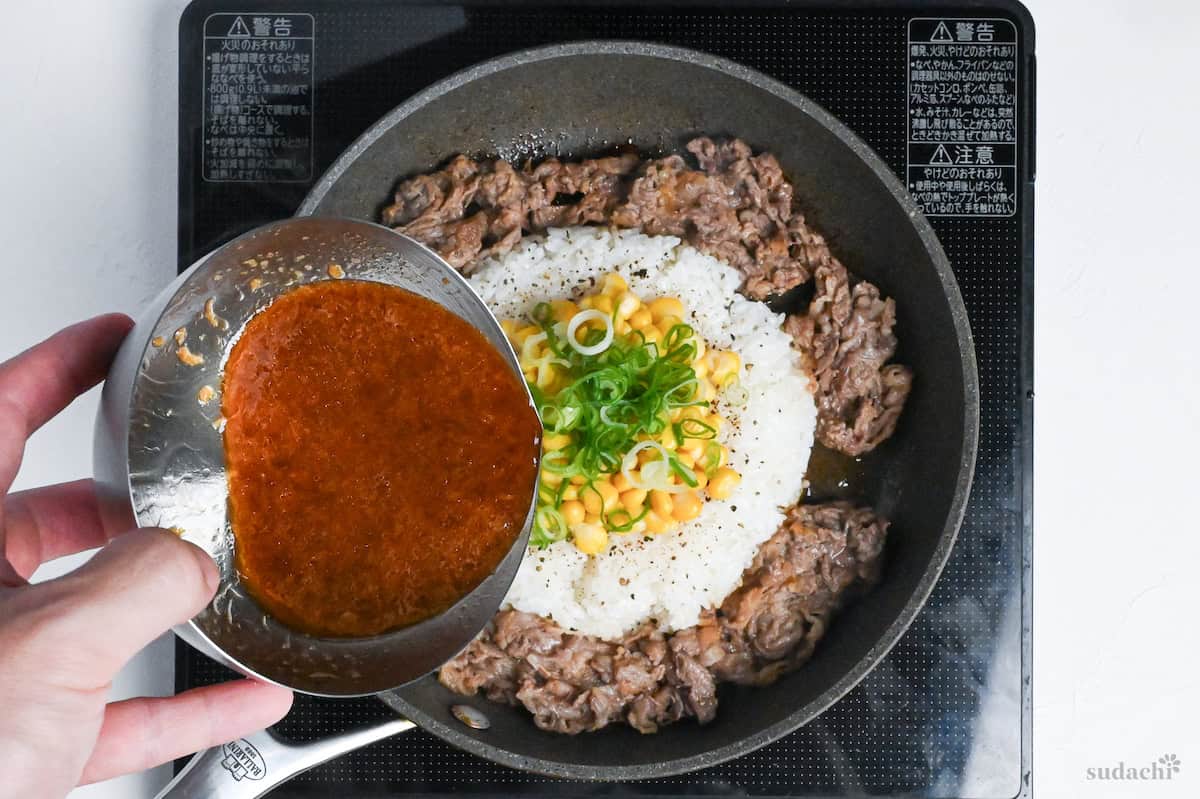
Increase the heat to medium-high and start mixing everything together. This will allow the bottom layer to develop those coveted crispy bits.
The moment you pour in that sauce, you might think, ‘Wait, this seems too watery! Is my rice about to turn into mush?’ Take a deep breath. We’re about to transform this into something amazing.

Once the moisture has evaporated and you can smell the toasty aroma, remove it from the heat.
Those golden, slightly charred bits at the bottom aren’t just for texture. They’re packed with flavor. In Japanese cooking, this is called “okoge.” It creates a delicious contrast between the tender, saucy rice and the nutty, crispy layer below.
Sprinkle dried parsley over the top for a pop of color and freshness, and add extra green onions if you’re feeling generous.

The dish is ready to serve directly from the pan! Part of pepper rice’s charm is that communal, sizzling presentation that brings everyone together around the table.

Storage Guide
If you have leftovers, store them in an airtight container in the refrigerator for up to 2 days. To recreate some of the crispy texture, reheat in a skillet over medium heat rather than using the microwave, though it won’t match the original quality.
For the best results, enjoy this dish fresh from the pan.
Serving Suggestions
FAQ
Pepper Lunch is a Japanese steak restaurant chain that specializes in sizzling beef pepper rice and steaks cooked on hot iron plates. It was founded in 1994 when the first location opened in Ofuna, Kanagawa Prefecture, Japan. The company celebrated its 30th anniversary in July 2024.
The restaurant’s signature dish is “Pepper Rice,” featuring rice and thinly sliced beef cooked together on a sizzling iron plate at your table. This DIY-style cooking allows customers to control how well-done their meat is and creates an interactive dining experience.
Traditional Pepper Lunch restaurants use beef short plate and chuck tender cuts, similar to what’s used in Japanese beef bowl chains. The meat is sliced very thin for quick cooking on the hot iron plates.
Applesauce and apple jam are great alternatives. You can also try pear or pineapple juice.
Ground beef isn’t the best choice for this recipe. If you’re looking for an alternative, try thinly sliced pork or diced chicken thighs. Just remember to adjust the cooking time accordingly.
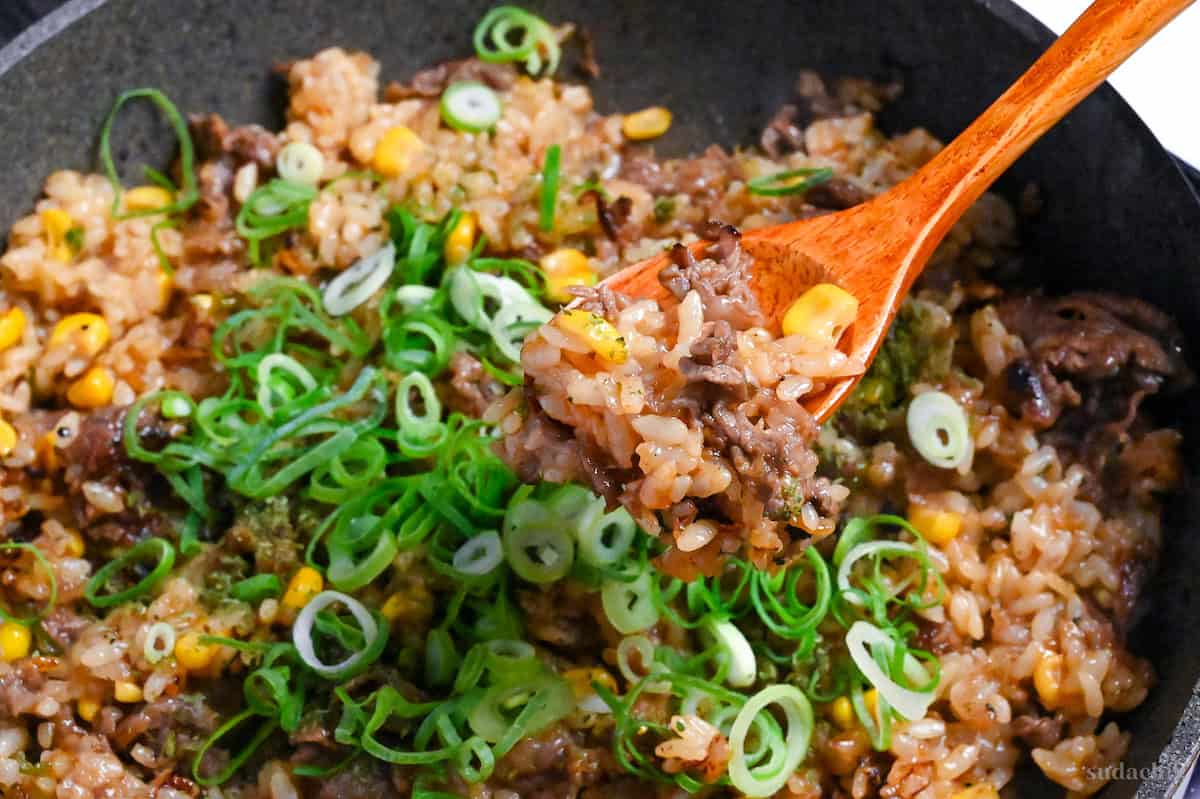
I hope you enjoy this Beef Pepper Rice recipe! If you try it out, I’d really appreciate it if you could spare a moment to let me know what you thought by giving a review and star rating in the comments below. It’s also helpful to share any adjustments you made to the recipe with our other readers. Thank you!
More Beef Recipes
Hungry for more? Explore my beef recipe collection to find your next favorite dishes!

One-Pan Beef Pepper Rice
Ingredients
- 200 g thinly sliced beef short plate or chuck
- 330 g cooked Japanese short-grain rice or Calrose rice (freshly cooked or day-old)
- ground black pepper to taste
- 50 g canned sweet corn well drained
- 4 tbsp finely chopped green onions
- 1 tbsp butter
- salt to taste
- dried parsley to taste
Sauce/Marinade
- 2 tbsp grated apple or apple juice
- 2 tbsp Japanese soy sauce (koikuchi shoyu)
- 1 tbsp mirin
- 1 tbsp sake or dry white wine
- 1 tbsp onion grated
- ½ tbsp tomato ketchup
- 1 clove grated garlic or garlic paste
- 1 tsp toasted sesame oil
- 1 tsp grated ginger root or ginger paste
- 1 tsp honey
- ½ tsp Chinese-style chicken bouillon powder or any bouillon powder
- ⅛ tsp chili powder
My recommended brands of ingredients and seasonings can be found in my Japanese pantry guide.
Can’t find certain Japanese ingredients? See my substitution guide here.
Instructions
- Mix the marinade ingredients in a bowl (2 tbsp grated apple, 2 tbsp Japanese soy sauce (koikuchi shoyu), 1 tbsp mirin, 1 tbsp sake, 1 tbsp onion, ½ tbsp tomato ketchup, 1 clove grated garlic, 1 tsp toasted sesame oil, 1 tsp grated ginger root, 1 tsp honey, ½ tsp Chinese-style chicken bouillon powder and ⅛ tsp chili powder).

- Place 200 g thinly sliced beef in a separate bowl and pour half of the marinade over the top. Mix until evenly covered and leave to marinate for 10 minutes. Save the other half of the marinade for later.

- Pack 330 g cooked Japanese short-grain rice into a bowl and turn it out in the center of a large frying pan. Sprinkle with a generous amount of freshly ground black pepper.

- Top the peppered rice with 50 g canned sweet corn, half the chopped green onions and 1 tbsp butter. Arrange the marinated beef around the rice.

- Cover the pan with a lid and place it on the stovetop over medium heat. When it starts to sizzle gently, set a timer for 5 minutes.

- After 5 minutes, remove the lid and pour the other half of the marinade around the pan. Increase the heat to medium-high and mix thoroughly.

- Stir fry for a couple of minutes or until the excess moisture has evaporated and there are some crispy bits at the bottom of the pan. Season with salt to taste and sprinkle with the rest of the chopped green onions and some dried parsley.

- Place the pan on a trivet on the table, give everyone a spoon and tuck in straight from the pan!

Notes
- Drain canned corn thoroughly.
- Listen for gentle, consistent sizzling sounds during the final stir-fry stage. This indicates the perfect temperature for creating crispy rice bits without burning.
- Store leftovers in the fridge for up to two days and reheat in a skillet over medium heat instead of in the microwave to get some crispiness back, but fresh is always best.
- Serving ideas: Egg Drop Soup, Miso Soup, Japanese Potato Salad, Pickled Cucumber




Leave a rating and a comment